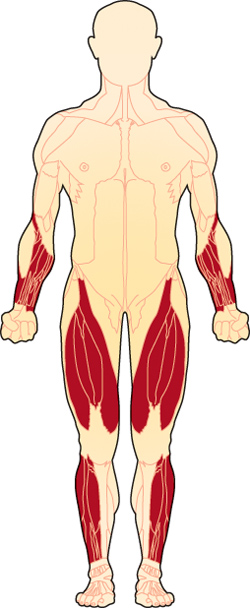
Inclusion-Body Myositis (IBM)
Inclusion-Body Myositis (IBM)
What is inclusion-body myositis (IBM)?
 Inclusion body myositis (IBM) is one of the most common disabling inflammatory myopathies among patients older than age 50. Based on two small studies conducted in the ’80s and ’90s, 1 to nearly 8 annual incidences of IBM are expected in every 1 million Americans.1
Inclusion body myositis (IBM) is one of the most common disabling inflammatory myopathies among patients older than age 50. Based on two small studies conducted in the ’80s and ’90s, 1 to nearly 8 annual incidences of IBM are expected in every 1 million Americans.1
Another word for inflammatory myopathy is myositis. The “myo” root means muscle, and the “itis” root means inflammation; thus, a myositis is an inflammatory muscle disease.
IBM is classified along with polymyositis, dermatomyositis, and autoimmune necrotizing myopathy as one of the idiopathic inflammatory myopathies (a group of disorders characterized by inflammation of the skeletal muscle). Inflammatory cells invade the muscle tissue and concentrate between the muscle fibers. A biopsy, taken from a patient diagnosed with IBM, presents multiple inclusion bodies that contain cellular material of dead tissue. IBM is named for the clumps of discarded cellular material — the "bodies" — that collect in the muscle tissues. Immune cells concentrate around these bodies.1
There are some genetic forms of IBM in which, for the most part, inflammation is not a major part of the picture. For this reason, these forms are often called inclusion-body myopathy (muscle disorder), leaving out the “itis” in the disease name to reflect the relative lack of inflammation. For more, see Causes/Inheritance.
What are the symptoms of IBM?
IBM causes progressive weakness of the muscles of the wrists and fingers, the muscles of the front of the thigh, and the muscles that lift the front of the foot. For more, see Signs and Symptoms.
What causes IBM?
The cause of inflammatory myopathies like IBM is unclear. The body’s immune system turns against its own muscles and damages muscle tissue in an autoimmune reaction. The cause of the muscle degeneration that occurs in IBM is unclear as well.
Genetic forms of IBM can be either dominant or recessive. For more, see Causes/Inheritance.
What is the progression of IBM?
Inclusion-body myositis (IBM) primarily affects men, although women can be affected.2 Patients diagnosed with IBM progress to disability usually over a period of years. The older the age of onset is, the faster the loss of strength and mobility. By 15 years, most patients require assistance with basic daily routines, and some become wheelchair- bound or bedridden.3,4 Natural history studies have not shown reduced lifespan, but most clinicians agree that IBM can be an indirect cause of death, mainly due to aspiration pneumonia in patients with difficulty swallowing (dysphagia). In rare cases, respiratory failure due to respiratory muscle weakness may occur.5
What is the status of research on IBM?
New research is rapidly leading to increased understanding of IBM. Scientists are examining factors that may trigger the disease such as viruses, certain drugs, or vaccines. All these factors are being studied so inflammatory myopathies like IBM can someday be better understood, treated, or perhaps prevented entirely.
References
- Inflammatory Muscle Diseases. N. Engl. J. Med. (2015). doi:10.1056/nejmc1506827
- Dimachkie, M. M. & Barohn, R. J. Inclusion body myositis topical collection on nerve and muscle. Curr. Neurol. Neurosci. Rep. (2013). doi:10.1007/s11910-012-0321-4
- Peng, A., Koffman, B. M., Malley, J. D. & Dalakas, M. C. Disease progression in sporadic inclusion body myositis: Observations in 78 patients. Neurology (2000). doi:10.1212/WNL.55.2.296
- Cortese, A. et al. Longitudinal observational study of sporadic inclusion body myositis: Implications for clinical trials. Neuromuscul. Disord. (2013). doi:10.1016/j.nmd.2013.02.010
- Voermans, N. C. et al. Primary respiratory failure in inclusion body myositis. Neurology (2004). doi:10.1212/01.WNL.0000145834.17020.86

